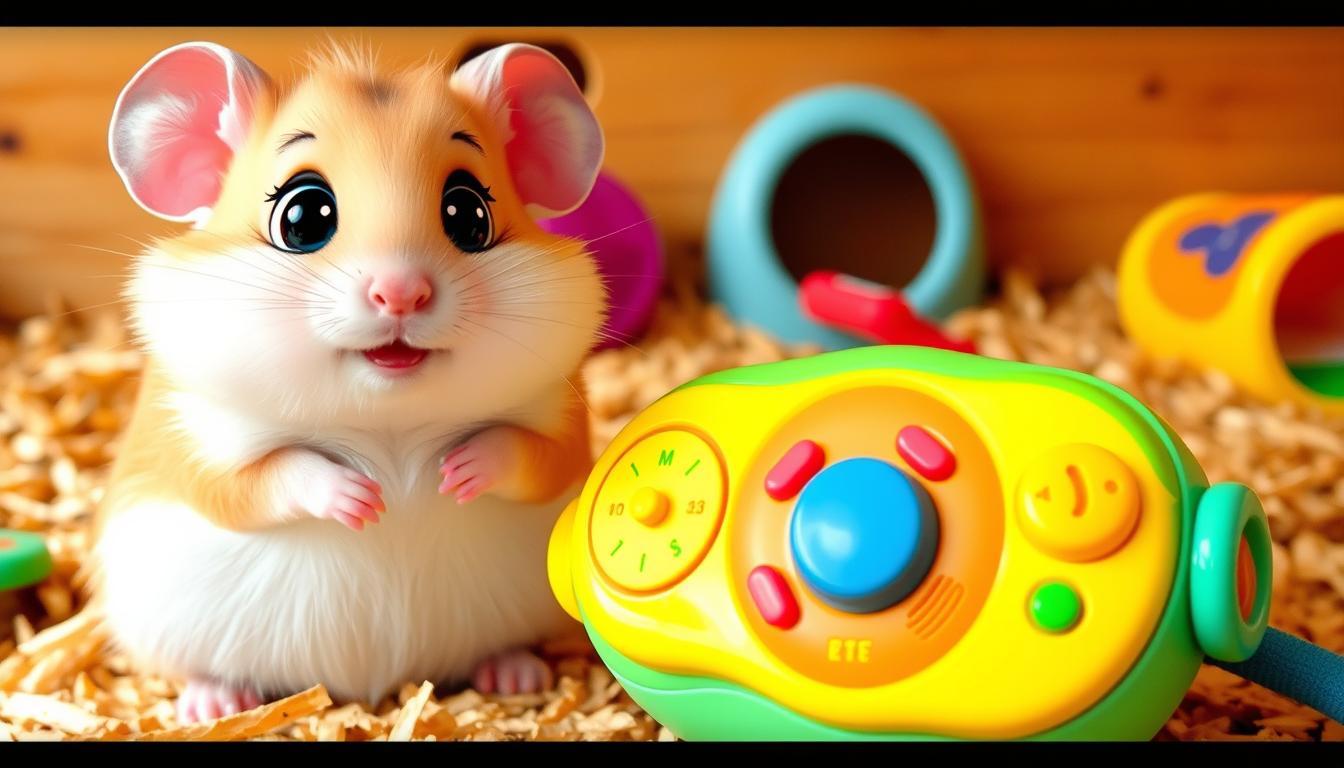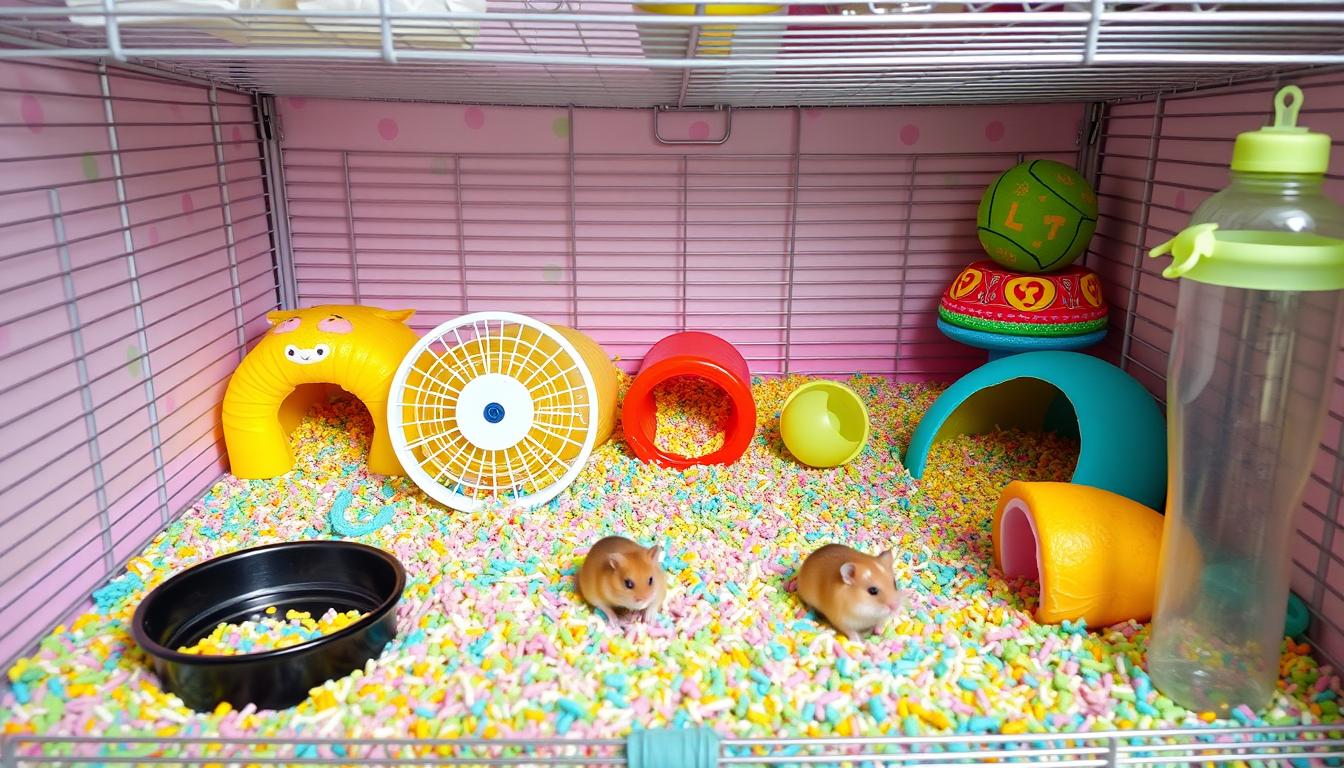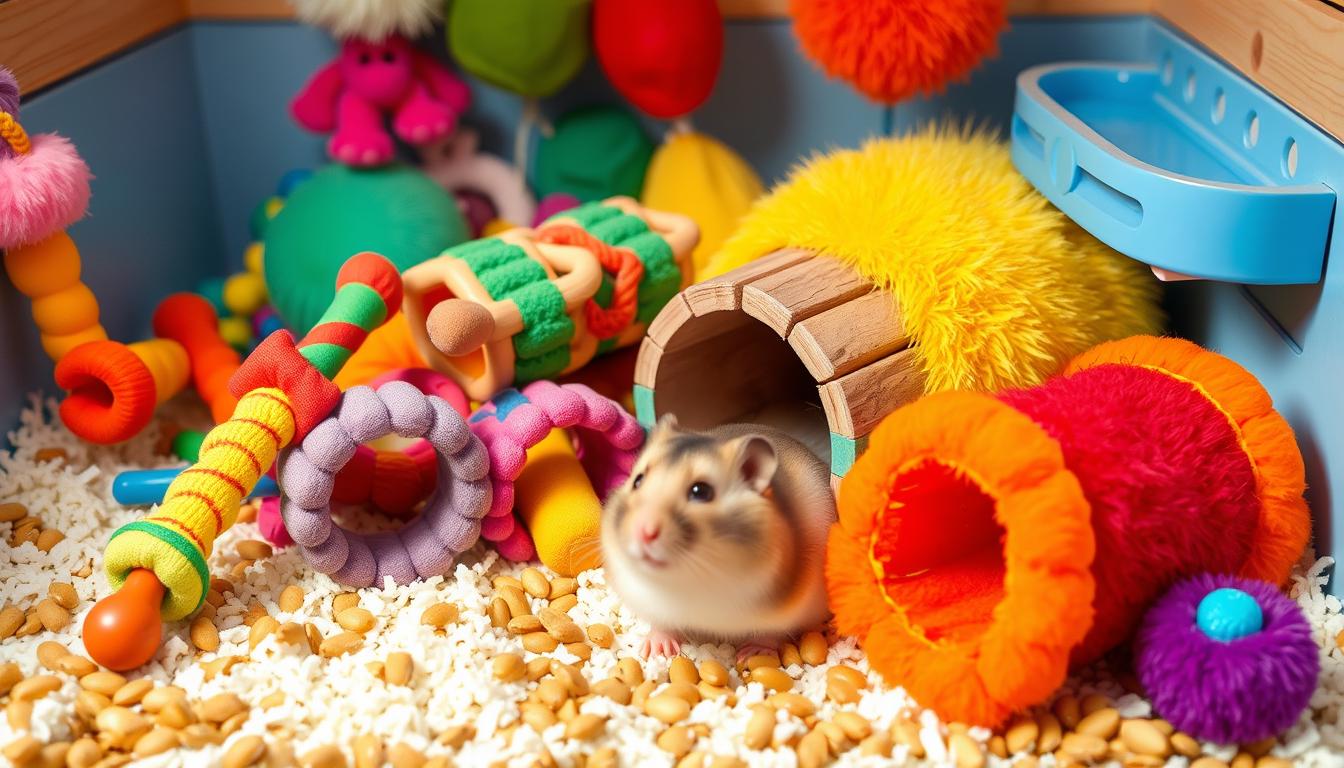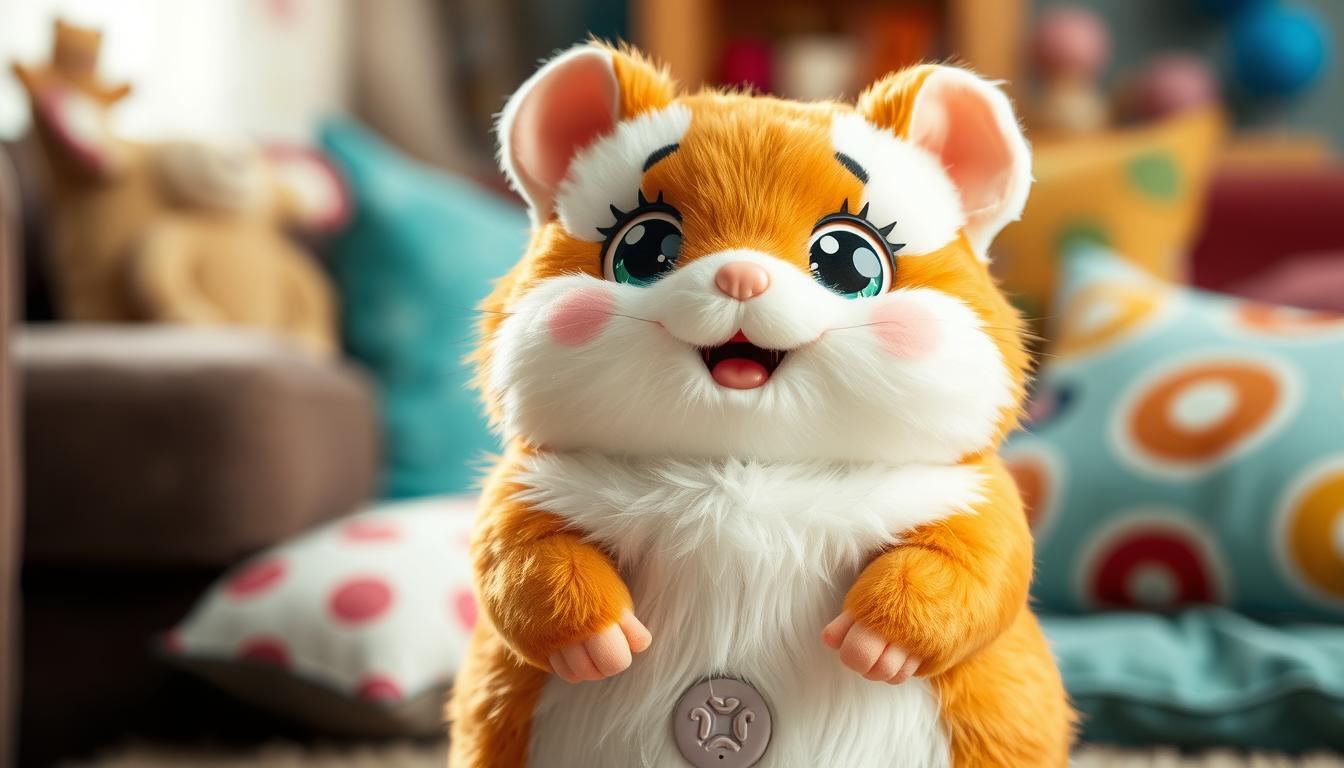If you love hamsters, you know they need the right chew toys. But did you know that talking hamster toys do more than just satisfy their chewing? They can also make your hamster happier and healthier.
Imagine a toy that makes your hamster smarter, healthier, and closer to you. Would you want to learn more about these amazing toys?
Key Takeaways
- Speaking hamster toys provide mental stimulation and enrich your pet’s playtime
- Choosing the right materials and designs is crucial for ensuring toy safety
- Proper introduction and supervision are key to integrating toys into your hamster’s routine
- Cleaning and maintaining toys regularly helps prevent health issues
- Understanding your hamster’s unique play preferences can help you select the most engaging toys
Understanding the Benefits of Speaking Hamster Toys
Adding speaking hamster toys to your pet’s playtime can open up a new world of fun and learning. These toys not only keep your furry friend’s mind sharp but also encourage them to chew. This is good for their health and happiness.
Enhancing Your Hamster’s Mental Stimulation
Speaking hamster toys, like robotic hamsters or speech recognition toys, are made to challenge your hamster’s brain. They play sounds or respond to your hamster’s voice, making them want to explore and learn. This keeps your pet’s mind active and prevents boredom.
Promoting Natural Chewing Behavior
Hamsters need to chew to keep their teeth and jaws healthy. Hamster plush toys and other speaking toys offer the right textures for chewing. This lets your pet satisfy their chewing instinct while playing.
“Speaking hamster toys not only entertain your pet but also contribute to their mental and physical development.”
Using speaking hamster toys in playtime is fun for both you and your pet. Knowing how these toys benefit your hamster helps create a happy and stimulating environment for them.
Choosing the Right Materials for Safety
When picking out toys for your hamster, safety is key. The materials in these toys can greatly affect your pet’s health. We’ll look at safe options and what to avoid to keep your hamster’s playtime fun and safe.
Safe Materials for Speaking Hamster Toys
For speaking hamster toys, the safest choices are:
- Untreated wood: Natural, unfinished wood is good for your hamster’s teeth.
- Cardboard: Sturdy, recycled cardboard lets your hamster chew and explore.
- Sisal: This natural fiber is tough and safe for your hamster to play with.
- Organic cotton: Soft, natural cotton is safe if your hamster decides to eat it.
These materials meet your hamster’s needs and keep them safe while playing.
Avoiding Harmful Substances
When choosing toys, stay away from harmful materials. Avoid:
- Plastics: Many plastics have harmful chemicals that can be toxic if eaten.
- Paints and dyes: Toys painted or dyed with certain chemicals can be dangerous.
- Metals: Small metal parts can choke your hamster or cause internal injuries.
- Adhesives: Some glues and adhesives used in toys can be harmful if swallowed.
By choosing safe materials and avoiding dangerous ones, you can make a safe and fun play area for your hamster.
“Ensuring the safety of your hamster’s toys is paramount to providing a happy and healthy playtime experience.”
Popular Types of Speaking Hamster Toys
As pet owners, we all want to give our furry friends the best care. For hamsters, using speech responsive toys and interactive pet toys is a great way to keep them curious. These toys not only entertain but also help with chewing and mental health.
Electronic Toys vs. Traditional Chew Toys
There are many types of speaking hamster toys, each with its own benefits. Electronic toys, like voice-activated houses or tunnels, offer a fun interactive experience. They play sounds or phrases, making your hamster feel like it’s talking.
Traditional chew toys are also great. Made from safe materials like wood, they let your hamster chew naturally. This helps keep their teeth healthy while they play.
Interactive Toys for Engaging Playtime
There are also many interactive pet toys available. These include puzzle feeders, mazes, and motorized toys. They challenge your hamster to solve problems and stay active.
Choosing the right toy for your hamster is important. Think about what they like, how active they are, and what’s safe. This way, you can find the perfect toy for their playtime.
How to Introduce Toys to Your Hamster
Adding new toys to your hamster’s space needs careful planning. Start by introducing toys slowly and watch how your hamster reacts. This way, you make sure your hamster enjoys the new additions.
Gradual Introduction Techniques
First, put the new toy in your hamster’s cage without touching it. Let your hamster get used to it at its own speed. This slow start helps avoid any stress or fear.
Observing Your Hamster’s Reactions
Watch how your hamster acts with the new toy. Look for signs of interest like sniffing or trying to climb on it. If your hamster seems scared, take the toy away and try again later. Always put your hamster’s happiness first.
As your hamster gets more comfortable, you can start playing together. Give treats or play with the toy. Remember, every hamster is different. Be patient and adjust the introduction to what your hamster likes best.
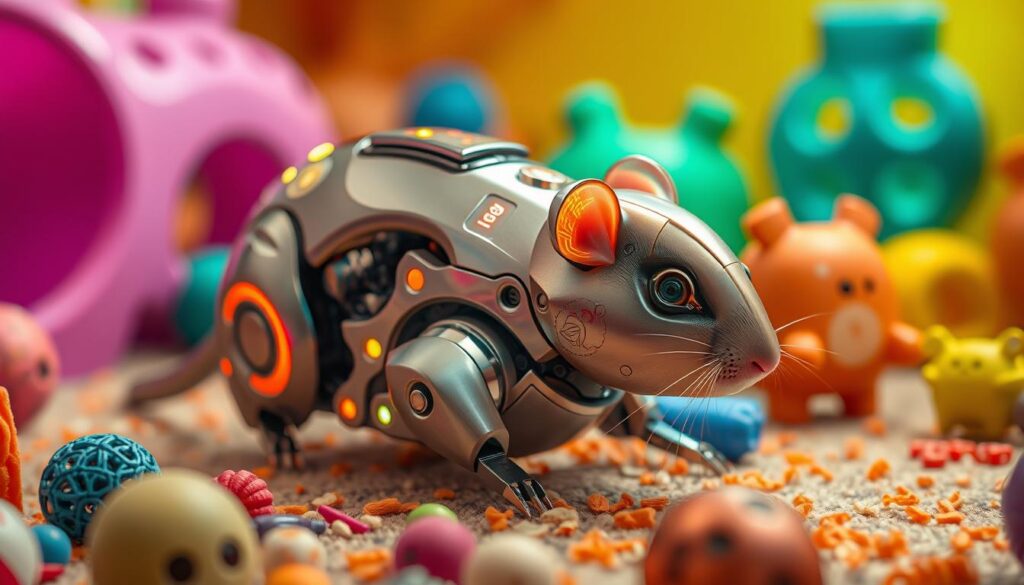
“Introducing new toys to your hamster should be a gradual and rewarding process, ensuring your furry friend feels safe and comfortable.”
By using these gentle steps and watching your hamster, you can add new toys to their life. This brings fun, keeps them busy, and strengthens your bond with your robotic hamster.
Cleaning and Maintaining Your Hamster Toys
Keeping your hamster’s toys clean is key for their health. Regular care makes these toys last longer. It also stops bacteria, odors, and dangers that could hurt your pet.
Best Practices for Toy Hygiene
To keep your hamster’s toys in great shape, follow these hygiene tips:
- Wash all toys with a mild, pet-safe soap and warm water every week.
- Make sure to rinse the toys well to remove soap, as hamsters can get irritated by chemicals.
- Let the toys dry completely before putting them back in your hamster’s home.
- Disinfect the toys once a month with a diluted bleach solution or a pet-safe cleaner.
- Don’t use harsh chemicals or rough cleaners that could harm the toys or your hamster.
Signs It’s Time to Replace the Toy
Even with good care, toys may need to be replaced sometimes. Watch for these signs:
- Look for cracks, chips, or loose parts due to wear and tear.
- If toys keep smelling bad after cleaning, it’s time for a new one.
- Visible mold or mildew is dangerous for your hamster and means it’s time for a new toy.
- Damage to the electronic parts of smart toys means they need to be replaced.
By cleaning and maintaining your hamster’s toys right, you ensure they have fun and safe playtime.
“Keeping your hamster’s toys clean and well-maintained is a small but important step in providing a healthy, enriched environment for your pet.”
Understanding Your Hamster’s Play Preferences
As a pet owner, knowing what your hamster likes to play with is key. This helps make playtime fun and enriching for them. By matching toys to their personality, you can make sure they have a great time.
Identifying Preferred Play Styles
Hamsters love to play and explore, but each one is different. Some like to run through tunnels or climb on AI-powered toys. Others might enjoy chewing on speech responsive toys or snuggling in cozy spots. Watching how your hamster plays can show you what they like best.
Tailoring Toy Choices to Your Hamster’s Personality
After figuring out what your hamster likes, pick toys that match. For active hamsters, talking hamster toys that encourage running and climbing are great. If your hamster likes to relax, choose toys for chewing, nesting, or just lounging. This way, you make sure they get the mental stimulation they need.
| Preferred Play Style | Recommended Toys |
|---|---|
| Active |
|
| Relaxed |
|
Understanding your hamster’s play preferences is an ongoing journey. Their interests can change, so be ready to adjust your approach. This ensures they stay happy and engaged with you.
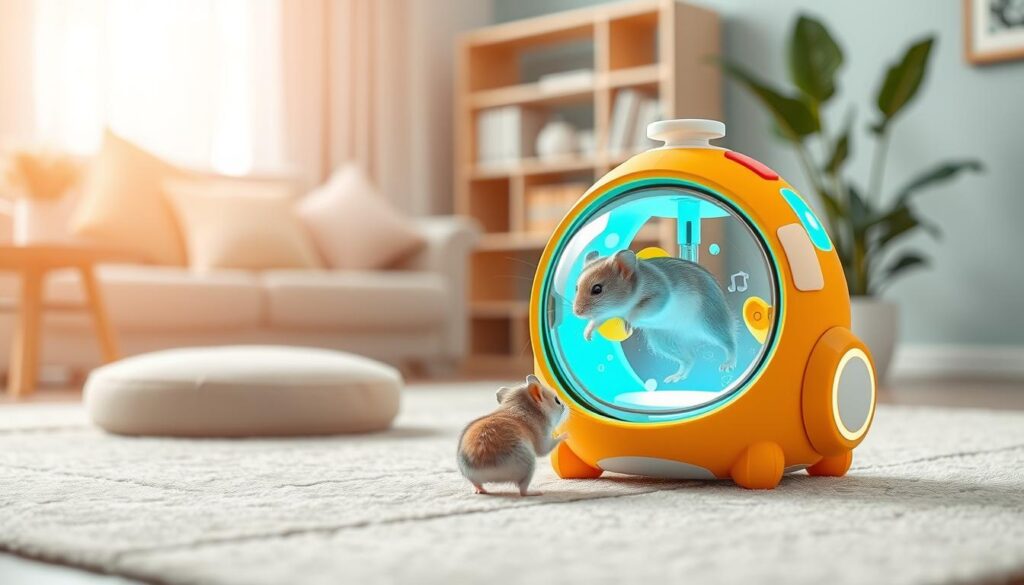
Tips for Engaging Playtime with Your Hamster
Playtime is key for your hamster’s daily life. It keeps them physically and mentally active. Here are some tips to make playtime fun and safe for your furry friend.
Setting Up a Safe Play Environment
Safety is the most important thing during playtime. Choose a safe area in your home for your hamster. Make sure it’s free from dangers like cords, small holes, or sharp things.
Use a strong, safe enclosure to keep your hamster safe. This will also prevent any accidents.
Creating Variety with Different Toys
Hamsters are curious and love to try new things. Use a variety of interactive pet toys, like robotic hamster or speech recognition toy, to keep them interested. Change the toys often to keep things exciting and prevent boredom.
- Give your hamster chew toys, tunnels, and climbing structures to meet their natural needs.
- Try hiding treats or food puzzles to challenge their problem-solving skills.
- Switch toys regularly to keep your hamster curious and engaged.
It’s important to know your hamster’s likes and dislikes. Watch them closely and adjust the toys and play area to keep them happy and entertained.
The Importance of Supervision During Play
Keeping an eye on your hamster during play is key. Toys that talk and other fun items can be great, but safety first. Without watching, your hamster might face dangers like choking or getting hurt.
Risks of Unsuitable Toys
Only pick toys made for hamsters and watch them closely. Big toys, small parts, or the wrong materials can be very dangerous. If your hamster swallows or gets stuck in these, it could be very serious.
Guidelines for Safe Playtime Monitoring
Always watch your hamster when they play with these toys. Look for any signs of trouble and step in if needed. Also, check the toys often for damage and swap them out to keep playtime safe and fun.

